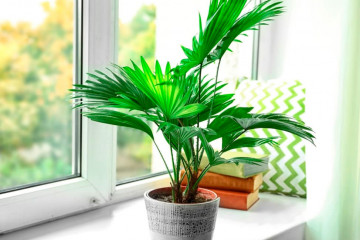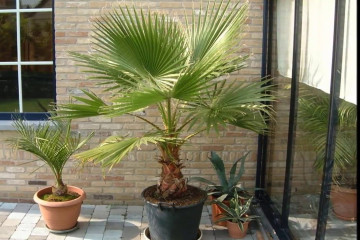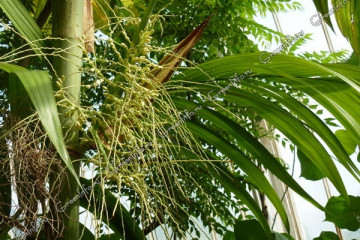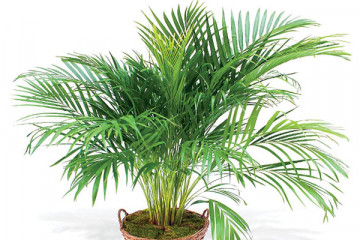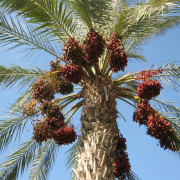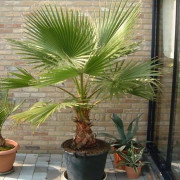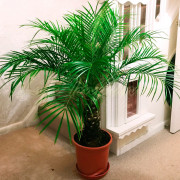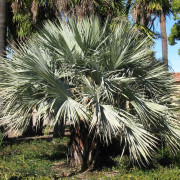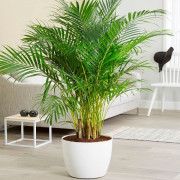Pachypodium lamera - home care
Content:
The pachypodium is a plant that has been gaining popularity among flower growers in recent years. Although the most common species is known as the Madagascar palm, it has nothing to do with palm trees. While the spiny columnar trunk indicates a cactus, the leaves are more palm-like. The trunk, like many succulents, serves as a reservoir for water. Pachypodium care is easy, even beginners can handle it.
Varieties of pachypodium
The pachypodium of the lamerei species, or the Madagascar palm, is the most common in the Pachypodium culture from the Kutrov family. This plant is native to Madagascar, where it can often be found in rocky limestone valleys.
The succulent plant has a tall, thick, spindle-shaped trunk covered with long 6-centimeter thorns, collected in 3 at the tips of clear, tight-fitting tubercles. In young plants, the trunk surface is dark green, in adults it is covered with silvery-gray scales.
The thorns are also silvery-gray in the middle, and brownish at the ends. Long leaves grow from the same tubercles as the thorns, only on the top of the stem. The peculiar shape is the reason to call Lamera a cactus with leaves on top of its head.
The length of the leaf blade can exceed 30 cm with a width of 9 cm, its surface is leathery, dark green, with a bright central vein. Large, up to 10 cm in diameter, flowers are collected in small umbellate inflorescences protruding above the leaves on low thick stems. Flower crowns have a narrow tube with a bright yellow inner part that opens with five wide, creamy white petals.
There are at least 20 types of pachypodiums. The most popular ones are:
- Pachypodium geayi (Zhaya). Very similar to Pachypodium lamerei. It differs only in narrower and less dense leaves. When growing at home, it reaches 60 cm;
- Pachypodium brevicaule (short stem). Originally from the center of Madagascar. Unusual appearance, the trunk resembles a stone covered with thorns. Gray shades give it in nature the maximum resemblance to the surrounding landscape. The yellow inflorescence against such a background is very impressive;
- Pachypodium saundersii. A spherical stem of a gray-green color, up to 1.5 m long, is covered with small thorns. The leaves are wide, with a tapering base; the flower of such a pachypodium is decorated with a white border;
- Pachypodium succulent. Comes from southern Africa. A cobblestone-like tree trunk buried in the ground, small pubescent leaves and needle-like pairs. Bell-shaped buds with pink and red sparks converging to the center on the petals;
- Pachypodium densiflorum (densely flowered). It has rich yellow flowers. It grows very slowly. Flowering begins when the stem reaches 30 cm in diameter. Maximum height - 45 cm;
- Pachypodium horombense Poiss. It belongs to undersized species with a strong, smooth stem. Thin leaves in rosettes at the ends of the shoots and large yellow flowers growing in bunches.
Lamer Pachypodium care
Care for a pachypodium plant at home is not particularly difficult, however, a number of mandatory conditions of detention must be observed. The pachypodium grows relatively quickly and can reach significant sizes in just 2-3 years. On average, growth is 15-30 cm per year, so you can start with a small plant. Flowering begins in adults about 5 years old.
Care features
Choice of habitat
If possible, it is good to take the plant out to the balcony or garden in the summer. But this can only be done in the absence of night frosts. An ideal place for a representative of exotic flora in the room is the south, southwest or southeast window. In winter, it is quite possible to be near the heater, dry and warm air is easily transferred.
Air humidity and watering
When caring for a pachypodium at home, it is not required to create high air humidity, which makes it easier to grow. In the wild, the plant tolerates both dry and rainy periods. Therefore, you need to know how to water the pachypodium.
Since it accumulates water in its trunk, it must be poured quite discreetly. However, the plant requires more water than most other succulents. The soft fiber inside the barrel absorbs water and acts as a kind of storage tank.
At the same time, stagnant moisture can damage this unusual plant. Root rot appears and the trunk simply collapses. The palm tree does not require spraying, but it can be done in order to wash off the dust.
Basic requirements for watering:
- wait for the soil to dry after each irrigation;
- use rainwater or well-settled tap water for irrigation.
Temperature and lighting
The favorite habitat of the pachypodium cactus is as warm as possible, with good lighting.
The pachypodium grows best at temperatures between 20 ° C and 24 ° C, while even tolerating temperatures of 30 degrees Celsius. But it is necessary to ensure that the temperature does not drop below + 18 ° C.
There is no rest, the growing season lasts all year, so in winter you need to try to extend the daylight hours by creating artificial lighting. Otherwise, the trunk expands greatly, the leaves become sparse and pale. In the least favorable conditions, they can partially fall off.
Top dressing and transplanting
To cover the need for nutrients, a single monthly feeding is sufficient, starting in April and ending in September. Fertilizers are introduced 2-3 weeks after the emergence of young shoots. Specialized formulations for cacti are suitable, which are added to irrigation water in a low concentration.
To optimally care for the pachypodium, a transplant is necessary, which takes into account the following aspects:
- transplant time - spring;
- regularity - every 2 or 3 years, young people - once a year;
- good drainage must be laid out in a new pot;
- it is not recommended to fertilize the plant immediately after transplanting.
Transplanting should be done very carefully, given that the plant has delicate roots. A plant with an earthy clod is neatly placed in a new pot, slightly larger than the previous one, on a layer of drainage and substrate. Then the soil is poured so that at least 2 cm remains to the edge, and it is pressed. Suitable type of soil - special for cacti. If it cooks on its own, then the leafy and sod land is mixed with river sand. Everything is taken in equal shares. After planting, abundant watering is performed.
The trunk and leaves of the pachypodium contain poisonous milky sap, which is harmful not only to humans, but also to animals.Symptoms of poisoning are diarrhea, urinary problems, fever and breathing problems in severe cases.
For the pachypodium, trimming the apex does not make sense. Only broken or otherwise damaged leaves should be trimmed or removed with a clean cutting tool. This procedure reduces the risk of entry of pathogenic microorganisms.
Due to the irritating and toxic effects of the plant, the cutting tool must be thoroughly cleaned before and after contact with the palm tree.
Growing problems
If the Madagascar palm is in the right place and with proper care, it rarely suffers from disease. However, errors in content lead to symptoms of various diseases.
Why do young leaves turn black
Typical mistakes are:
- lack of light;
- too cold place (the plant reacts especially negatively when it stands on a cold floor);
- very rare, but excessive watering;
- irrigation with cold water, which leads to darkening of the leaves.
A weakened palm is especially susceptible to fungal spores. Then the young leaves of the pachypodium turn black and dry. Means of struggle can be immediate plant transplantation and limitation of watering.
Pests on the pachypodium are still rare enough. They can be scale insects or spider mites. If they appear, the plant must be treated with insecticides.
Why does the palm tree not bloom
Many florists are concerned about why the pachypodium is not blooming. This plant rarely blooms in general at home. Sometimes, with regular feeding and careful care, plants over 5-6 years old delight their owners with charming flowers.
Reproduction
Vegetative
It is not easy to grow a young pachypodium, reproduction is carried out mainly with the help of lateral shoots. Cuttings are prepared from them. The difficulty is that the lateral shoots of the palm tree give rise only after a few years. A stalk can also be cut from the top of the plant. If, for example, the pachypodium is damaged by root rot, it can be saved this way.
Stages of vegetative reproduction:
- A healthy and strong shoot is selected, cut off with a clean knife as close to the mother plant as possible;
- To prevent rotting and increase the chance of rooting, the cut must be dry. The optimal time is 24 hours, but 12 hours is enough;
- After drying, the cut is treated with charcoal;
- Then the cutting must be planted in a pot with a substrate to a depth of 4-5 cm;
- The soil should be saturated with moisture, but not wet;
- Placed in a bright and warm place, the cutting is covered with a transparent film and aired daily.
Root formation can take several weeks. Propagation of the pachypodium by cuttings will be successful if they are regularly watered and kept in a warm place.
Growing from seeds
You can get seeds from a houseplant only after artificial pollination during the flowering period. Since the Madagascar palm tree does not always bloom, the seeds can be purchased at a flower shop.
The main stages of obtaining young plants of the Lamer pachypodium from seeds when grown at home:
- Immediately before starting the procedure, immerse the seeds in warm water and leave there for 2 hours;
- Sow them on the substrate mixture, sprinkle with soil only slightly on top;
- Moisten the soil well and cover the container with seeds with foil;
- Place in a warm and bright place, such as a sunny windowsill. Germination temperature - from 24 ° С to 26 ° С;
- Not too abundant watering is carried out as the soil dries slightly;
- When the sprouts are up to 10 cm, they can be transferred individually to the pots.
The Madagascar palm is very easy to care for and is therefore suitable for any amateur grower, regardless of experience. It is important to use optimally maintained, well-dosed irrigation and the plant will give any interior an exotic look.












